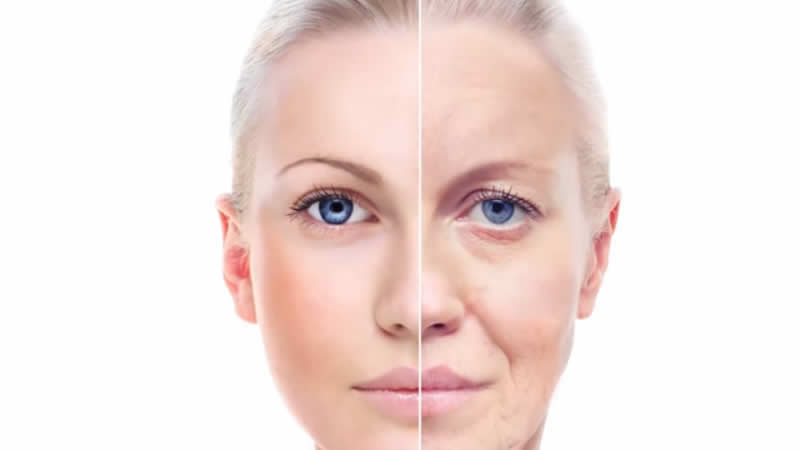
Photo Aging protection is very important if you want to avoid premature aging. Let’s discuss what it is and then how you can protect yourself.
What is Photo Aging?
Photo aging is characterised by wrinkles, loss of skin tone and resilience.
Photoaged skin shows damage in the connective tissue and elastin with severe loss of collagen. Collagen is very important to maintain because it is key to youthful looking skin.
Ultraviolet generated reactive oxygen free (ROS) radicals deplete and damage the skins own antioxidant defense system. It also causes permanent genetic changes. Free radicals cause tissue damage and ultimately more senescence cells (cellular death).
“It is well known that the UV light in sunlight can cause and accelerate photoaging in the white skin of Caucasians. Kadunce et al. [53] reported that sun exposure of more than 50,000 h (in total lifetime hours) is associated with a 3.1-fold increased risk for wrinkling in white skin, compared with exposure of less than 50,000 h.” Ref
Reactive Oxygen free radical damage using sunscreens and other forms of protection is important to minimise the effects of Photo AGING.
Use toxin free sunscreen to provide photo aging protection
The best photo aging protection is to use a sunscreen. It is difficult to know which sunscreens are safe and which are not. Picking a safe sunscreen is tricky especially when you don’t know what ingredients to avoid. Then the next questions are which ingredients are safe.
I know personally I avoid going out in the sun because of photo damage. However if you are going to go out and need to know which chemicals to avoid use our list below
Below are the top (near unpronounceable) ingredients to avoid and why you should stay away from them, the best ingredients for effective and safe UVA/UVB protection, and other tactics you can use so that your summer can be saved!
Ingredients to avoid in sunscreen
Oxybenzone
This is currently in approximately 65% of all sunscreens available in the US. It is used in sunscreen as a penetration enhancer but can result in an eczema-like allergic reaction.
According to the Environmental Working Group, there are several suspected dangers associated with Oxybenzone. Despite its sun protective abilities, it has been shown to penetrate the skin and cause photo-sensitivity. As a photocarcinogen, it has demonstrated an increase in the production of harmful free radicals and an ability to attack DNA.
What is incredible it has been linked to a rise in the cases of melanoma cases with sunscreen users. It can also mimic estrogen and may be linked to breast cancer. Ref
Retinyl Palmitate (Also known as Vitamin A Palmitate):
This substance is included as an antioxidant, to help improve the performance of the sunscreen against the aging effects of UVA and UVB rays. The problem is this type of vitamin A breaks down when exposed to UV rays. This in turn results in free radicals and DNA damage.
“ In 2006, for instance, scientists found in laboratory studies that when subjected to UVA light, retinyl palmitate acted as a “photosensitizer,” leading to free radical formation and the peroxidation of fatty cells. In other words, when retinyl palmitate was exposed to UV rays, it created changes in the skin that could lead to damage, aging, and cancer.” Ref
Homosalate
This substance is UV ray-absorbing – hence, why it is often included as an ingredient in sunscreen. The problem is it accumulates in the body. It is also known as an endocrine disruptor. Homosalate impacts the body’s hormone systems, and in particular, the estrogen system. It has the ability to cause a hormone imbalance. Ref
Octocrylene
This substance is particularly effective at absorbing UVA rays, which penetrate deeper than UVB rays. UVA can be more harmful than UVB rays. This ingredient can cause excess free radical damage that can interfere with cellular signaling, cause mutations, lead to cell death or cell senescence. It is also considered an environmental toxin and harmful to coral. Ref
Paraben Preservatives
There’s a chance that they’re harmful. Studies have shown that some parabens can mimic the activity of the hormone estrogen in the body’s cells, and while estrogenic activity is associated with certain forms of breast cancer, parabens have been found present in breast tumors.
Methylisothiozolinone (inactive ingredient)
This substance was noted as “Allergen of the Year-2013” by the American Contact Dermatitis Society. Methylisothiazolinone is a widely-used preservative; has been associated with allergic reactions. Lab studies on the brain cells of mammals also suggest that methylisothiazolinone may be neurotoxic. Ref
Octinoxate
In sunscreens with SPF, it is a substance readily absorbed and thus helps others to be absorbed too.
This common sunscreen ingredient is shown to have hormone-mimicking effects on laboratory animals. Meaning it can disrupt hormone balance. It can mimic estrogen and can cause more free radical damage due to the release of free radicals in UV light.
Photo Aging Protection – How to protect yourself
- Wear a wide-brimmed hat.
- Use sun protective clothing.
- Protect yourself under shelter from the sun. If you are on the beach use a UV protection tent.
- Look for broad spectrum sunscreen. This means it protects from UVA and UVB. Look for a sunscreen that uses zinc oxide and titanium dioxide in nanoparticles. Do not apply to broken areas. The reason is you want it to stay on the surface of the skin and not get into your bloodstream or be ingested. These ingredients are toxic once it gets inside the body. Make sure you apply frequently as is wears off quickly. No sunscreen is waterproof.
Photo Aging Protection in you day cream
Photo Aging protection is critical to prevent the early onset of wrinkles and lines. Therefore, UV protection in a face cream is recommended. Sisel’s Actify6000 contains ingredients that protect against UV exposure. It is around 15 spf+ so reapplying is recommended.
The great thing about reapplying Sisel’s Actify6000 is that it locks in moisture. Skin that is well moisturized maintains a more youthful appearance. Sisel’s Actify6000 contains no harmful ingredients and has the Sisel Safe stamp. The Mower Mission which started in 1989 was to produce products with no harmful ingredients. To this day the Sisel Mission continues with the Sisel Safe products.
Sisel’s AGE Pill can also provide protection against UV damage. Nicotinamide an active ingredient in the AGE Pill has protective effects against ultraviolet damage caused by sun exposure. Ref
Last Updated on March 27, 2023 by Katie Sisel Distributor
